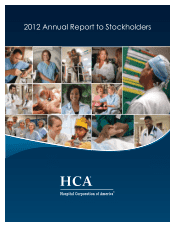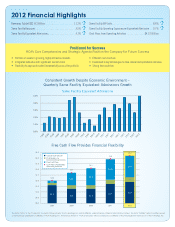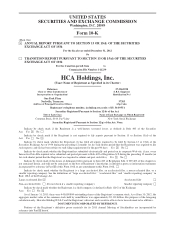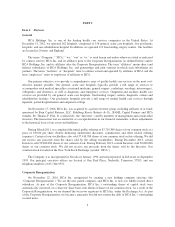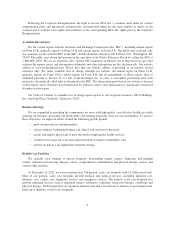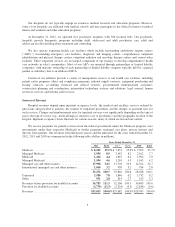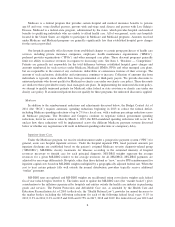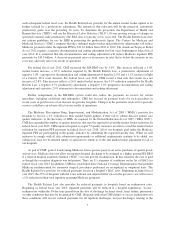HCA Holdings 2012 Annual Report Download - page 11
Download and view the complete annual report
Please find page 11 of the 2012 HCA Holdings annual report below. You can navigate through the pages in the report by either clicking on the pages listed below, or by using the keyword search tool below to find specific information within the annual report.each subsequent federal fiscal year, the Health Reform Law provides for the annual market basket update to be
further reduced by a productivity adjustment. The amount of that reduction will be the projected, nationwide
productivity gains over the preceding 10 years. To determine the projection, the Department of Health and
Human Services (“HHS”) will use the Bureau of Labor Statistics (“BLS”) 10-year moving average of changes in
specified economy-wide productivity (the BLS data is typically a few years old). The Health Reform Law does
not contain guidelines for use by HHS in projecting the productivity figure. The Centers for Medicare and
Medicaid Services (“CMS”) estimates that the combined market basket and productivity adjustments will reduce
Medicare payments under the inpatient PPS by $112.6 billion from 2010 to 2019. The American Taxpayer Relief
Act of 2012 requires a negative documentation and coding adjustment for four years beginning in federal fiscal
year 2014. It is estimated that this documentation and coding adjustment will reduce Medicare inpatient PPS
payments by $10.5 billion. A decrease in payment rates or an increase in rates that is below the increase in our
costs may adversely affect our results of operations.
For federal fiscal year 2012, CMS increased the MS-DRG rate by 1.0%. This increase reflected a 3.0%
market basket increase, a 0.1% reduction required by the Health Reform Law, a productivity adjustment of
negative 1.0%, a prospective documentation and coding adjustment of negative 2.0% and a 1.1% increase in light
of a January 2011 court decision. For federal fiscal year 2013, CMS issued a final rule that results in a net
increase of 2.8%. This increase reflects a 2.6% market basket increase, the 0.1% reduction required by the Health
Reform Law, a negative 0.7% productivity adjustment, a negative 1.9% prospective documentation and coding
adjustment and a positive 2.9% retrospective documentation and coding adjustment.
Further realignments in the MS-DRG system could also reduce the payments we receive for certain
specialties, including cardiology and orthopedics. CMS has focused on payment levels for such specialties in
recent years in part because of an increase in specialty hospitals. Changes in the payments received for specialty
services could have an adverse effect on our results of operations.
The Medicare Prescription Drug, Improvement, and Modernization Act of 2003 (“MMA”) provides for
hospitals to receive a 2% reduction to their market basket updates if they fail to submit data for patient care
quality indicators to the Secretary of HHS. As required by the Deficit Reduction Act of 2005 (“DRA 2005”),
CMS has expanded the number of quality measures that must be reported to avoid the market basket reduction. In
federal fiscal year 2013, CMS requires hospitals to report 55 quality measures in order to avoid the market basket
reduction for inpatient PPS payments in federal fiscal year 2014. All of our hospitals paid under the Medicare
inpatient PPS are participating in the quality initiative by submitting the requested quality data. While we will
endeavor to comply with all data submission requirements as additional requirements continue to be added, our
submissions may not be deemed timely or sufficient to entitle us to the full market basket adjustment for all of
our hospitals.
As part of CMS’ goal of transforming Medicare from a passive payer to an active purchaser of quality goods
and services, Medicare does not allow an inpatient hospital discharge to be assigned to a higher paying MS-DRG
if a selected hospital acquired condition (“HAC”) was not present on admission. In this situation, the case is paid
as though the secondary diagnosis was not present. There are 11 categories of conditions on the list of HACs for
federal fiscal year 2013. In addition, CMS has established three National Coverage Determinations that prohibit
Medicare reimbursement for erroneous surgical procedures performed on an inpatient or outpatient basis. The
Health Reform Law provides for reduced payments based on a hospital’s HAC rates. Beginning in federal fiscal
year 2015, the 25% of hospitals with the worst national risk-adjusted HAC rates in the previous year will receive
a 1% reduction in their total inpatient operating Medicare payments.
The Health Reform Law also provides for reduced payments to hospitals based on readmission rates.
Beginning in federal fiscal year 2013, inpatient payments will be reduced if a hospital experiences “excess”
readmissions within the 30-day time period from the date of discharge for heart attack, heart failure, pneumonia
or other conditions that may be designated by CMS. Hospitals with what CMS defines as excess readmissions for
these conditions will receive reduced payments for all inpatient discharges, not just discharges relating to the
7

